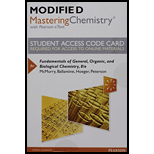
Concept explainers
(a)
Interpretation:
The term base pairing has to be identified.
Concept Introduction:
Composition of
Sugar: In both DNA and RNA, sugar portion is found. In DNA, the sugar is D-ribose, where at 2’hydroxyl group is absent and in RNA, the hydroxyl group is present at 2’.
Nitrogenous bases: Five types of nitrogenous bases (has unique one-letter code A, G, T, U, and C) are derived from two parent compounds called purine and pyrimidine. The purine derivatives are Adenine and Guanine are two fused nitrogen containing rings. The pyrimidine derivatives are Thymine, Cytosine, and Uracil are only one nitrogen containing six-membered ring.
b)
Interpretation:
Base that pair with other bases, in DNA has to be identified.
Concept Introduction:
Composition of nucleic acid: Nucleic acid is a polymer of nucleotides. Each nucleotide has three parts: a sugar, a nitrogenous base, and a phosphate group. Two nucleotides are joined by phosphate diester linkage where a free phosphate on 5’ carbon of one nucleotide and a free –OH group on 3’ carbon of another nucleotide.
Sugar: In both DNA and RNA, sugar portion is found. In DNA, the sugar is D-ribose, where at 2’hydroxyl group is absent and in RNA, the hydroxyl group is present at 2’.
Nucleotide: (Nucleoside + phosphate)
Nucleotides are the building blocks of nuclei acids; monomers of DNA and RNA polymers. At carbon-5’ of the ribose sugar, a phosphate group is added which is collectively known as nucleotide. Phosphate groups can be added to any of the nucleotide to form diphosphate or triphosphate.
Nitrogenous bases: Five types of nitrogenous bases (has unique one-letter code A, G, T, U, and C) are derived from two parent compounds called purine and pyrimidine. The purine derivatives are Adenine and Guanine are two fused nitrogen containing rings. The pyrimidine derivatives are Thymine, Cytosine, and Uracil are nitrogen-containing six-membered ring.
c)
Interpretation:
Number of Hydrogen bonds does each base pair possess has to be interpreted.
Concept Introduction:
Composition of nucleic acid: Nucleic acid is a polymer of nucleotides. Each nucleotide has three parts: a sugar, a nitrogenous base, and a phosphate group. Two nucleotides are joined by phosphate diester linkage where a free phosphate on 5’ carbon of one nucleotide and a free –OH group on 3’ carbon of another nucleotide.
Nitrogenous bases: Five types of nitrogenous bases (has unique one-letter code A, G, T, U, and C) are derived from two parent compounds called purine and pyrimidine. The purine derivatives are Adenine and Guanine, which are two fused nitrogen containing rings. The pyrimidine derivatives are Thymine, Cytosine, and Uracil, which are nitrogen-containing six-membered ring.
Hydrogen bonding: The electrostatic attraction exists between high electronegative atom and hydrogen atom.
Want to see the full answer?
Check out a sample textbook solution
Chapter 26 Solutions
Modified Mastering Chemistry With Pearson Etext -- Standalone Access Card -- For Fundamentals Of General, Organic, And Biological Chemistry (8th Edition)
- DNA contains many hydrogen bonds. Are hydrogen bonds stronger or weaker than covalent bonds? What are the consequences of this difference in strength?arrow_forwardwhat is a peptide bond? what characteristic of nucleic acids makes them important in determining heredity? how do DNA and RNA differ in chemical composition?arrow_forwardWhat are the monomers that makeup a nucleic acid and what are the monomers composed of? What type of bond is found along the backbone of the DNA backbone?arrow_forward
- How many combinations of DNA bases are for a polynucleotide of 7 base pairs in length?arrow_forwardIf the GC content of a DNA molecule is 60%, what are the molar percentages of the four bases (G, C, T, A)?arrow_forwardComplementary base pairing between nucleotides makes which process possible?arrow_forward
- What tetrapeptide is synthesized from the informational DNA sequence G-T-C-A-G-T-A-C-G-T-T-A?arrow_forwardWhat does it mean to speak of bases as being complementary?arrow_forwardDNA and RNA are chemically very similar but are distinguished, in large part, by the presence of a 2’-OH group in RNA and a 2’-H group in DNA. Why do you suppose that both DNA and RNA have 3’-OH groups and we do not typically find nucleic acids within cells that have 3’-H groups?arrow_forward
- How many hydrogen bonds will be involved in base pairing in a DNA molecule of 50 base pairs that contains 13 cytosine bases?arrow_forwardDescribe in detail the structure of DNA. Of what is a nucleotide composed? Which are thepurines and pyrimidines? What are the bonding rules? What kind of bond holds the two DNAstrands together?arrow_forwardWhat are the 3 parts of a nucleotide?arrow_forward
 Human Heredity: Principles and Issues (MindTap Co...BiologyISBN:9781305251052Author:Michael CummingsPublisher:Cengage Learning
Human Heredity: Principles and Issues (MindTap Co...BiologyISBN:9781305251052Author:Michael CummingsPublisher:Cengage Learning Biology: The Dynamic Science (MindTap Course List)BiologyISBN:9781305389892Author:Peter J. Russell, Paul E. Hertz, Beverly McMillanPublisher:Cengage Learning
Biology: The Dynamic Science (MindTap Course List)BiologyISBN:9781305389892Author:Peter J. Russell, Paul E. Hertz, Beverly McMillanPublisher:Cengage Learning

